2021-01-02 Daily-Challenge
Today is Saturday, I gonna review the tasks I've done this week, and finish today's leetcode's January LeetCoding Challenge with cpp.
LeetCode Review
Merge Two Sorted Lists
too easy to review
Sort Array By Parity II
too easy to review
Construct Quad Tree
too easy to review
Check Array Formation Through Concatenation
too easy to review
Task Scheduler
no need to review
Reach a Number
no need to review
Pseudo-Palindromic Paths in a Binary Tree
no need to review
Largest Rectangle in Histogram
use a stack just need one iteration
class Solution {
public:
int largestRectangleArea(vector<int>& heights) {
vector<int> st{-1};
heights.push_back(0);
int len = heights.size();
int answer = 0;
for(int i = 0; i < len; ++i) {
while(st.size() && st.back() != -1 && heights[i] < heights[st.back()]) {
int index = st.back();
st.pop_back();
int h = heights[index];
int w = i - st.back() - 1;
answer = max(answer, h*w);
}
st.push_back(i);
}
return answer;
}
};
Game of Life
another way to enumerate
class Solution {
public:
void gameOfLife(vector<vector<int>>& board) {
int rows = board.size();
int cols = board[0].size();
for(int i = 0; i < rows; ++i) {
for(int j = 0; j < cols; ++j) {
int count = 0;
for(int row = max(0, i-1); row <= min(rows-1, i+1); ++row) {
for(int col = max(0, j-1); col <= min(cols-1, j+1); ++col) {
count += (board[row][col]&1);
}
}
count -= board[i][j];
if(count == 3 || (count == 2 && board[i][j] == 1)) {
board[i][j] |= 2;
}
}
}
for(auto &row : board) {
for(auto &cell : row) {
cell >>= 1;
}
}
}
};
Lowest Common Ancestor of a Binary Tree
using parent pointers
class Solution {
unordered_map<TreeNode*, int> level;
unordered_map<TreeNode*, TreeNode*> parent;
void build(TreeNode *root) {
if(!root) return;
if(root->left) {
level[root->left] = level[root] + 1;
parent[root->left] = root;
build(root->left);
}
if(root->right) {
level[root->right] = level[root] + 1;
parent[root->right] = root;
build(root->right);
}
}
public:
TreeNode* lowestCommonAncestor(TreeNode* root, TreeNode* p, TreeNode* q) {
build(root);
while(level[p] > level[q]) p = parent[p];
while(level[q] > level[p]) q = parent[q];
while(q != p) {
p = parent[p];
q = parent[q];
}
return q;
}
};
January LeetCoding Challenge 2
Description
Find a Corresponding Node of a Binary Tree in a Clone of That Tree
Given two binary trees original and cloned and given a reference to a node target in the original tree.
The cloned tree is a copy of the original tree.
Return a reference to the same node in the cloned tree.
Note that you are not allowed to change any of the two trees or the target node and the answer must be a reference to a node in the cloned tree.
Follow up: Solve the problem if repeated values on the tree are allowed.
Example 1:
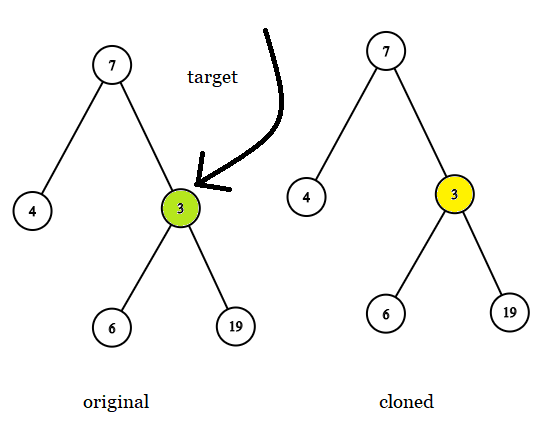
Input: tree = [7,4,3,null,null,6,19], target = 3
Output: 3
Explanation: In all examples the original and cloned trees are shown. The target node is a green node from the original tree. The answer is the yellow node from the cloned tree.
Example 2:
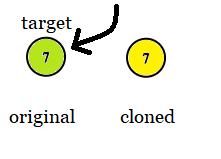
Input: tree = [7], target = 7
Output: 7
Example 3:
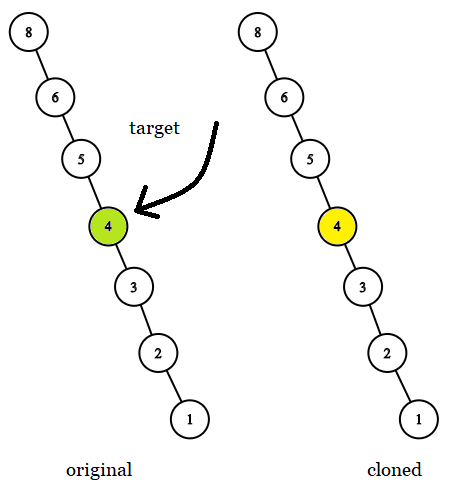
Input: tree = [8,null,6,null,5,null,4,null,3,null,2,null,1], target = 4
Output: 4
Example 4:
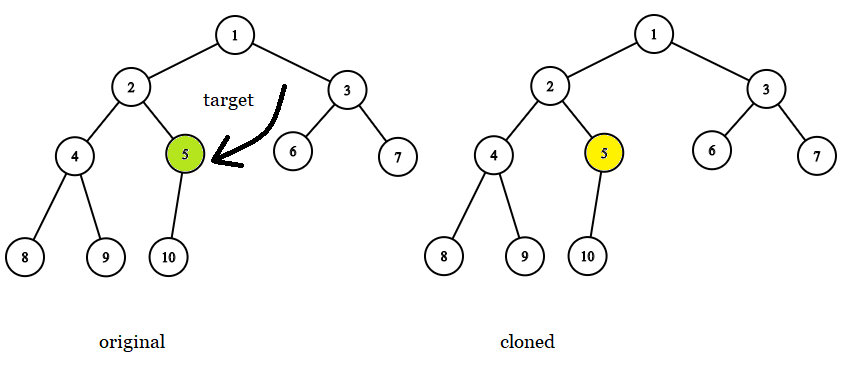
Input: tree = [1,2,3,4,5,6,7,8,9,10], target = 5
Output: 5
Example 5:
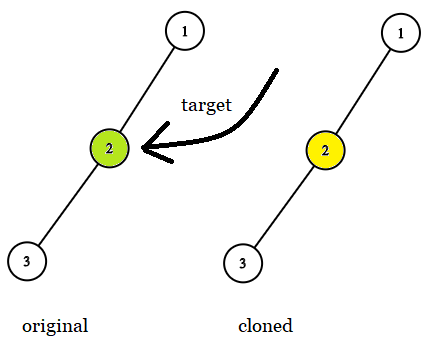
Input: tree = [1,2,null,3], target = 2
Output: 2
Constraints:
- The number of nodes in the
treeis in the range[1, 10^4]. - The values of the nodes of the
treeare unique. targetnode is a node from theoriginaltree and is notnull.
Solution
class Solution {
public:
TreeNode* getTargetCopy(TreeNode* original, TreeNode* cloned, TreeNode* target) {
if(!original) return nullptr;
if(original == target) return cloned;
TreeNode *left = getTargetCopy(original->left, cloned->left, target);
if(left) return left;
TreeNode *right = getTargetCopy(original->right, cloned->right, target);
if(right) return right;
return nullptr;
}
};